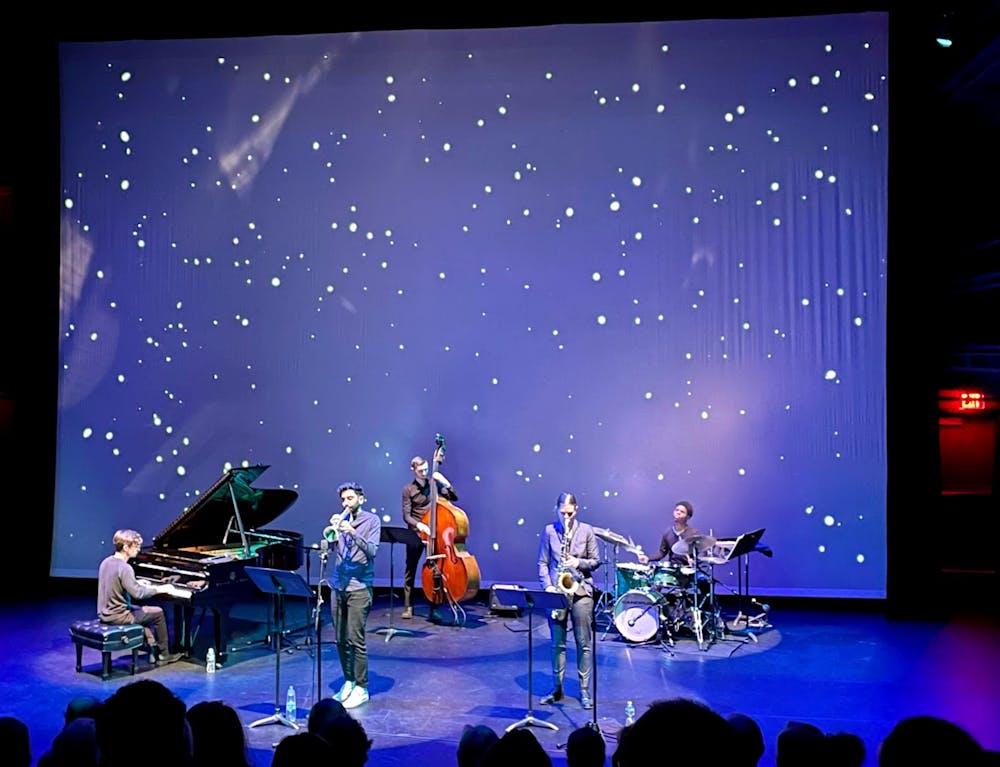The year 2021 is a momentous one for Mary Lou Williams’ “Zodiac Suite,” claimed reviewer Seth Colter Walls in a New York Times article from this March. Chris Pattishall’s “Zodiac” is surely a highlight in this year of significant recognition for the phenomenal suite. Pattishall, a Durham native that will be an artist-in-residence at Duke for the next year, is heavily influenced by Mary Lou Williams (1910-1981).
The setup inside the von der Heyden Studio Theater at Rubenstein Art Center was tailored to Pattishall’s world premiere of “Zodiac.” The stage started telling the story of “Zodiac” even before the music, with dim purple lighting and the large screen awash in starry constellations.
Chris Pattishall said between two pieces in the performance, “Mary Lou Williams’ music has changed my life [...] Coming into contact with it, investigating it and sharing it with people […] the last ten years has been an incredibly enriching experience.”
“Mary Lou, in addition to being an incredible musician, […] the piece of it for me that hits closer to home is her commitment to community and all the things that she did to take care of the family of musicians that she loved and cared for, taught, nourished, and helped endlessly throughout her life.”
"Taurus"
The 12 movements began with Taurus, Mary Lou’s zodiac sign. In this opening movement, the music reflected a ceaseless motion through the cosmos. The melody transitioned back and forth from bustle to quiescence. The piano notes were bright, clear, and full. Then entered the trumpet with extended sounds. Percussions joined in, and later the trumpet returned, in an ascending fashion, gathering momentum. At the latter half of the third minute, the reverberating note of the trumpet conjured a vision of floating in the air, thus entering the cosmos and exploring the zodiacs.
"Gemini"
A segmented, repetitive scale played out on the trombone, trumpet, and saxophone, creating the image of one fairy-like creature chasing another.
"Cancer"
Riley Mulherkar on the trumpet led the listeners in with mid-range to low-range sounds, swaying, buoyant, like a slow dancer gliding on marble floor until the piano joins in. This was the piece in the Zodiac Suite that initially mesmerized Pattishall in 2011 and brought back his memory of listening to Geri Allen perform the suite at Duke, while Pattishall was still a teenager. The movement briefly came to a halt midway until unassuming notes succeeded it, leaving intentional blank spaces for the listeners’ mind to wander in the cosmos.
"Leo"
This movement prominently featured percussion sounds, even a little rowdy, perhaps to reflect the passion of the lion.
"Virgo"
Piano notes were struck right from the beginning, accompanied first by percussion and then by the saxophone: graceful yet cheeky. Like two youthful tap dancers facing off in a dance contest.
"Libra"
This was a relatively meditative melody, especially at the beginning. The pace was slow and unhurried. Only the piano notes could be heard, for the most part. Simple, exerting restraint and elegance.
"Sagittarius"
Piano was the highlight of this movement. Sagittarius felt akin to improvisation — the notes did not seem to be pointing to a specific direction, but rather as a free roam, returning to a motif from time to time.
"Capricorn"
Capricorn was heavy on the bass and the lower ranges of piano keys leading in. Soon, the percussion instruments joined in, and then the saxophones. After a period of stir and momentum-building, the trombone eased the melody out into a brief respite. After the blank period, the percussion sounds started rolling in again, as did the trumpet, saxophone, and trombone, as they motioned the movement toward a gradual end.
"Aquarius"
This was a much more relaxed, playful movement than Capricorn. The cheerful saxophone melody in the second half of the first minute gave the impression of a crisp morning when the sun was rising. Beginning from around the second minute, the brass instruments took on a life of its own. When they receded, the piano sounds would take over the empty space, complementing each other and blending perfectly.
"Pisces"
This movement had a contemplative and tender start, transitioning to a waltz-like tempo. Steady. Controlled, but not restrictive. The addition of percussion immediately after the second minute made the movement much more lively.
"Aries"
The swinging energy bounced off right from the beginning. The movement featured the brass sounds, with percussion maintaining the rhythm in the background initially, and then an added piano twist. The piano keys glided over the keyboard with ease. Toward the end, the saxophone pulled in the percussion, which made sounds resembling that of a fierce wind rattling through a wood, or, more fittingly, a space shuttle racing through the deep cosmos.
Closing with Williams’ “My Mama Pinned a Rose on Me,” Pattishall offered a breathtaking prologue to his year-long residency with Duke Performances. His residency continues the legacy of Williams, the first artist-in-residence at Duke, a legacy that, according to Pattishall, “will live on for a very long time.”
Get The Chronicle straight to your inbox
Signup for our weekly newsletter. Cancel at any time.
Katherine Zhong is a Trinity junior and local arts editor of The Chronicle's 119th volume.

